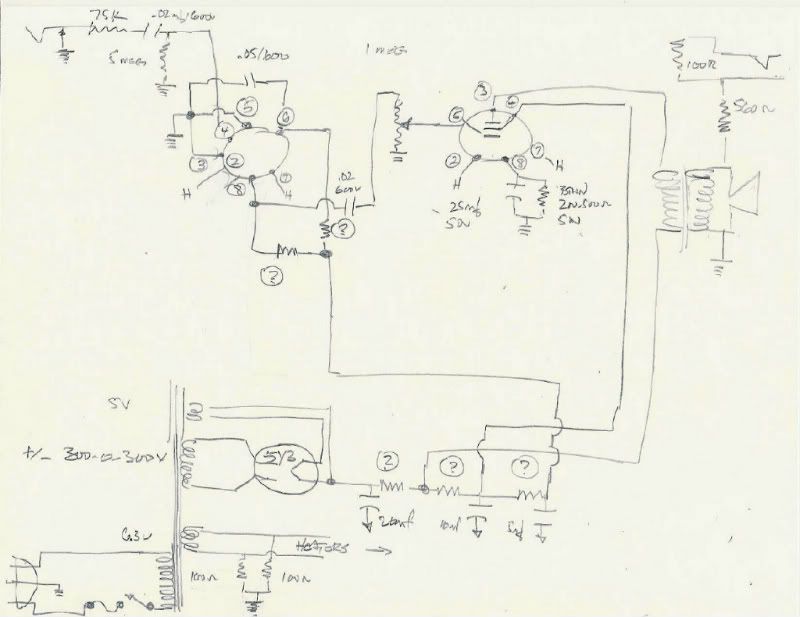littlesongs
Member
Juan, Coastie, Default, Fixit and Walter are all inspirational. Seeing what kind of fantastic DIY stuff they can do makes me want to try something too. While just in the planning stages at the moment, this thread will be home to the tiny tubey thingy. The "ttt" is a humble concept for a small combo amp that will also work as a head.
The power section will be salvaged from a first generation signal tester like the Eico 145 or Heathkit T-1. They run under $20 and come with a simple as heck single ended 3 watt amplifier circuit: 6X5 rectifier, 6SJ7 preamp, and 6K6 output. Oddly enough, these old signal testers tend to sound pretty decent bone stock in their rattly metal boxes, but I want to be able to use that low volume saturated sound for recordings too.
So far, my list of mods/repairs includes a three prong mains with a fuse, a better power transformer with the same values, new caps, input and output jacks, and since it will be used as a either a head or a combo, an output transformer with 4, 8 and 16 ohm taps. I'll post the Eico 145 literature and would greatly appreciate any insight you all might have into making this simple circuit work safely and happily.
Once the electrical bits are sorted, the amp will be mounted with a small speaker inside the shell of an early '40s fabric covered wooden portable radio like a Zenith Universal. The second matching radio shell would be modded into an extension cab. In the end, I hope to have a pair of cases that could be toted easily, but look too ratty or esoteric to be attractive to thieves.
If the idea actually works, a little three tube single ended amp will be pushing around 3 crunchy watts through a 6" speaker in an attractive portable unit from a bygone era. The real challenge is to put the whole thing together for under $150 using easily found components, inexpensive tubes and junk from the bargain bin at a Hamfest.
The Fender 5C1 and Silvertone 1331 are both three tube designs with a following, so I figured this wouldn't be completely without precedent, right? I have limited experience with tubes, but thought this might be a good way to get my feet wet in a matter of speaking. Is this a totally nutty idea, or does it have some potential?
The power section will be salvaged from a first generation signal tester like the Eico 145 or Heathkit T-1. They run under $20 and come with a simple as heck single ended 3 watt amplifier circuit: 6X5 rectifier, 6SJ7 preamp, and 6K6 output. Oddly enough, these old signal testers tend to sound pretty decent bone stock in their rattly metal boxes, but I want to be able to use that low volume saturated sound for recordings too.
So far, my list of mods/repairs includes a three prong mains with a fuse, a better power transformer with the same values, new caps, input and output jacks, and since it will be used as a either a head or a combo, an output transformer with 4, 8 and 16 ohm taps. I'll post the Eico 145 literature and would greatly appreciate any insight you all might have into making this simple circuit work safely and happily.
Once the electrical bits are sorted, the amp will be mounted with a small speaker inside the shell of an early '40s fabric covered wooden portable radio like a Zenith Universal. The second matching radio shell would be modded into an extension cab. In the end, I hope to have a pair of cases that could be toted easily, but look too ratty or esoteric to be attractive to thieves.
If the idea actually works, a little three tube single ended amp will be pushing around 3 crunchy watts through a 6" speaker in an attractive portable unit from a bygone era. The real challenge is to put the whole thing together for under $150 using easily found components, inexpensive tubes and junk from the bargain bin at a Hamfest.
The Fender 5C1 and Silvertone 1331 are both three tube designs with a following, so I figured this wouldn't be completely without precedent, right? I have limited experience with tubes, but thought this might be a good way to get my feet wet in a matter of speaking. Is this a totally nutty idea, or does it have some potential?
